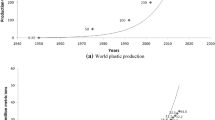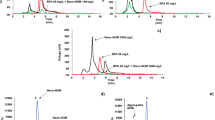Abstract
The brominated flame retardant bis(2-ethylhexyl)-3,4,5,6-tetrabromophthalate (TBPH) is used widely in consumer items including polyurethane foam used in furniture. Information on its bioaccumulation in aquatic species is limited. In the current study, sediment bioaccumulation tests with the oligochaete Lumbriculus variegatus were performed on a spiked natural sediment equilibrated for 14.5 months. Analysis showed the TBPH used to spike the sediment contained a small amount (0.046% by mass) of mono-(2-ethylhexyl)-3,4,5,6-tetrabromophthalate (TBMEHP), a potential biotransformation product of the parent chemical. Steady-state biota-sediment accumulation factors (BSAFs) of 0.254 and 1.50 (kg organic carbon/kg lipid) were derived for TBPH and TBMEHP, respectively. TBPH had biphasic elimination behavior where 94% of the body burden was depleted within the first 12 h of elimination (i.e., half-life of 1.2 h or less) and the remaining 6% eliminated very slowly thereafter (half-life of 15 days). There was little evidence for biotransformation of either chemical by L. variegatus. This investigation confirms the extremely hydrophobic behavior of TBPH and its impact on its bioavailability.


Similar content being viewed by others
References
Ali N, Eqani SAMAS, Ismail IMI, Malarvannan G, Kadi MW, Albar HMS, Rehan M, Covaci A (2016) Brominated and organophosphate flame retardants in indoor dust of Jeddah, Kingdom of Saudi Arabia: implications for human exposure. Sci Total Environ 569:269–277
Ankley GT, Cook PM, Carlson AR, Call DJ, Swenson JA, Corcoran HF, Hoke RA (1992) Bioaccumulation of PCBs from sediments by oligochaetes and fishes: comparison of laboratory and field studies. Can J Fish Aquat 49:2080–2085
Antweiler RC, Taylor HE (2008) Evaluation of statistical treatments of left-censored environmental data using coincident uncensored data sets: I. Summary statistics. Environ Sci Technol 42:3732–3738
Bearr JS, Stapleton HM, Mitchelmore CL (2010) Accumulation and DNA damage in fathead minnows (Pimephales promelas) exposed to 2 brominated flame-retardant mixtures, Firemaster® 550 and Firemaster® BZ-54. Environ Toxicol Chem 29:722–729
Bearr JS, Mitchelmore CL, Roberts SC, Stapleton HM (2012) Species specific differences in the in vitro metabolism of the flame retardant mixture, Firemaster® BZ-54. Aquat Toxicol 124:41–47
Benoit DA, Phipps GL, Ankley GT (1993) A sediment testing intermittent renewal system for the automated renewal of overlying water in toxicity tests with contaminated sediments. Water Res 27:1403–1412
Boesten J, Aden K, Beigel C, Beulke S, Dust M, Dyson J, Fomsgaard I, Jones R, Karlsson S, Van der Linden A (2005) Guidance document on estimating persistence and degradation kinetics from environmental fate studies on pesticides in EU registration. Report of the FOCUS Work Group on Degradation Kinetics, EC Doc. Ref. Sanco/10058/, version
Bradley EL, Burden RA, Bentayeb K, Driffield M, Harmer N, Mortimer DN, Speck DR, Ticha J, Castle L (2013a) Exposure to phthalic acid, phthalate diesters and phthalate monoesters from foodstuffs: UK total diet study results. Food Addit Contam A 30:735–742
Bradley EL, Burden RA, Leon I, Mortimer DN, Speck DR, Castle L (2013b) Determination of phthalate diesters in foods. Food Addit Contam A 30:722–734
Burkhard LP, Mount DR, Highland TL, Hockett JR, Norberg-King T, Billa N, Hawthorne SB, Miller DJ, Grabanski CB (2013) Evaluation of PCB bioaccumulation by Lumbriculus variegatus in field-collected sediments. Environ Toxicol Chem 32:1495–1503
Burkhard LP, Hubin-Barrows D, Billa N, Highland TL, Hockett JR, Mount DR, Norberg-King TJ, Hawthorne S, Miller DJ, Grabanski CB (2015) Sediment bioaccumulation test with Lumbriculus variegatus: effects of feeding. Arch Environ Contam Toxicol 68:696–706
Burkhard LP, Hubin-Barrows D, Billa N, Highland TL, Hockett JR, Mount DR, Norberg-King TJ (2016) Sediment bioaccumulation test with Lumbriculus variegatus: effects of organism loading. Arch Environ Contam Toxicol 71:70–77
Burkhard LP, Lahren T, Highland TL, Hockett JR, Mount DR, Norberg-King TJ (2019) Bioaccumulation of highly hydrophobic chemicals by Lumbriculus variegatus. Arch Environ Contam Toxicol 76:129–141
de Jourdan BP, Hanson ML, Muir DC, Solomon KR (2013) Environmental fate of three novel brominated flame retardants in aquatic mesocosms. Environ Toxicol Chem 32:1060–1068
de Jourdan BP, Hanson ML, Muir DC, Solomon KR (2014) Fathead minnow (Pimephales promelas Rafinesque) exposure to three novel brominated flame retardants in outdoor mesocosms: bioaccumulation and biotransformation. Environ Toxicol Chem 33:1148–1155
Fromme H, Becher G, Hilger B, Völkel W (2016) Brominated flame retardants—exposure and risk assessment for the general population. Int J Hyg Environ Heal 219:1–23
Great Lakes Solutions (2010) Technical Information DP-45TM. Milwaukee, WI, USA. Accessed 15 Apr 2020. http://greatlakes.com/deployedfiles/ChemturaV8/GreatLakes/Flame%20Retardants/FR%20Products/DP-45%20TDS.pdf.
Guo J, Venier M, Salamova A, Hites RA (2017) Bioaccumulation of Dechloranes, organophosphate esters, and other flame retardants in Great Lakes fish. Sci Total Environ 583:1–9
Hanson KB, Hoff DJ, Lahren TJ, Mount DR, Squillace AJ, Burkhard LP (2019) Estimating n-octanol-water partition coefficients for neutral highly hydrophobic chemicals using measured n-butanol-water partition coefficients. Chemosphere 218:616–623
Houde M, Berryman D, de Lafontaine Y, Verreault J (2014) Novel brominated flame retardants and dechloranes in three fish species from the St. Lawrence River. Canada Sci Total Environ 479:48–56
La Guardia MJ, Hale RC, Harvey E, Mainor TM, Ciparis S (2012) In situ accumulation of HBCD, PBDEs, and several alternative flame-retardants in the bivalve (Corbicula fluminea) and Gastropod (Elimia proxima). Enviro Sci Technol 46:5798–5805
Landrum PF, Lydy MJ, Lee H (1992) Toxicokinetics in aquatic systems: model comparisons and use in hazard assessment. Environ Toxicol Chem 11:1709–1725
Leppänen MT, Kukkonen JV (2004) Toxicokinetics of sediment-associated polybrominated diphenylethers (flame retardants) in benthic invertebrates (Lumbriculus variegatus, oligochaeta). Environ Toxicol Chem 23:166–172
Li H, Zhang B, Wei Y, Wang F, Lydy MJ, You J (2014) Bioaccumulation of highly hydrophobic organohalogen flame retardants from sediments: application of toxicokinetics and passive sampling techniques. Environ Sci Technol 48:6957–6964
McGrath TJ, Morrison PD, Ball AS, Clarke BO (2018) Concentrations of legacy and novel brominated flame retardants in indoor dust in Melbourne, Australia: an assessment of human exposure. J Environ Int 113:191–201
Mount DR, Dawson TD, Burkhard LP (1999) Implications of gut purging for tissue residues determined in bioaccumulation testing of sediment with Lumbriculus variegatus. Environ Toxicol Chem 18:1244–1249
Nash JC (2016) nlmrt: functions for nonlinear least squares solutions
Newton S, Sellström U, de Wit CA (2015) Emerging flame retardants, PBDEs, and HBCDDs in indoor and outdoor media in Stockholm, Sweden. Environ Sci Technol 49:2912–2920
Phipps GL, Ankley GT, Benoit DA, Mattson VR (1993) Use of the aquatic oligochaete Lumbriculus variegatus for assessing the toxicity and bioaccumulation of sediment-associated contaminants. Environ Toxicol Chem 12:269–279
Roberts SC, Macaulay LJ, Stapleton HM (2012) In vitro metabolism of the brominated flame retardants 2-ethylhexyl-2,3,4,5-tetrabromobenzoate (TBB) and bis (2-ethylhexyl)2,3,4,5-tetrabromophthalate (TBPH) in human and rat tissues. Chem Res Toxicol 25:1435–1441
RStudio (2018) RStudio: integrated development environment for R (Version 1.1.463) [Computer software]. Boston, MN. http://www.rstudio.org
Spacie A, Hamelink JL (1982) Alternative models for describing the bioconcentration of organics in fish. Environ Toxicol Chem 1:309–320
Stapleton HM, Allen JG, Kelly SM, Konstantinov A, Klosterhaus S, Watkins D, McClean MD, Webster TF (2008) Alternate and new brominated flame retardants detected in US house dust. Environ Sci Technol 42:6910–6916
Stapleton HM, Sharma S, Getzinger G, Ferguson PL, Gabriel M, Webster TF, Blum A (2012) Novel and high volume use flame retardants in US couches reflective of the 2005 PentaBDE phase out. Environ Sci Technol 46:13432–13439
Tian S, Zhu L (2011) Bioaccumulation kinetics of sediment-associated DE-83 in benthic invertebrates (Nereis succinea, polychaete). Chemosphere 84:160–165
US Environmental Protection Agency (2020) Estimation Programs Interface Suite™ for Microsoft® Windows, v 4.11. United States Environmental Protection Agency, Washington, DC, USA
US-EPA (2000) Methods for measuring the toxicity and bioaccumulation of sediment: associated contaminants with freshwater invertebrates. EPA/600/R-99/064, Office of Research and Development, Duluth, MN and Office of Water, Washington, DC
US-EPA (2015) TSCA work plan chemical technical supplement—use and exposure of the brominated phthalates cluster (BPC) chemicals brominated phthalates cluster flame retardants, EPA Document# 740-Q1-4002 August 2015. Office of Chemical Safety and Pollution Prevention, Washington, DC
Van Handel E (1985) Rapid determination of total lipids in mosquitoes. J Am Mosq Control Assoc 1:302–304
Zhang B, Li H, Wei Y, You J (2013) Bioaccumulation kinetics of polybrominated diphenyl ethers and decabromodiphenyl ethane from field-collected sediment in the oligochaete, Lumbriculus variegatus. Environ Toxicol Chem 32:2711–2718
Zhang W, Li J, Liu K, Lin K (2015) The behavior and toxicological effects of decabromodiphenyl ether (BDE209) in a soil–earthworm system. Sci Total Environ 537:377–384
Zhu B, Lai NLS, Wai T-C, Chan LL, Lam JCW, Lam PKS (2014) Changes of accumulation profiles from PBDEs to brominated and chlorinated alternatives in marine mammals from the South China Sea. Environ Int 66:65–70
Acknowledgements
The authors thank Robert Burgess and Guilherme Lotufo for reviewing this manuscript. The information in this document has been funded wholly by the U.S. Environmental Protection Agency. It has been subjected to review by the Center for Computational Toxicology and Exposure (CCTE) and approved for publication. Approval does not signify that the contents reflect the views of the Agency, nor does mention of trade names or commercial products constitute endorsement or recommendation for use.
Author information
Authors and Affiliations
Corresponding author
Ethics declarations
Conflict of interest
The authors declare they have no conflicts of interest.
Supplementary Information
Below is the link to the electronic supplementary material.
Rights and permissions
About this article
Cite this article
Burkhard, L.P., Lahren, T.J., Highland, T.L. et al. Bioaccumulation of Bis-(2-ethylhexyl)-3,4,5,6-tetrabromophthalate and Mono-(2-ethylhexyl)-3,4,5,6-tetrabromophthalate by Lumbriculus variegatus. Arch Environ Contam Toxicol 80, 579–586 (2021). https://doi.org/10.1007/s00244-021-00824-4
Received:
Accepted:
Published:
Issue Date:
DOI: https://doi.org/10.1007/s00244-021-00824-4




